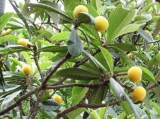Ursolic Acid
111Category: Pharmaceuticals and Biochemicals/Herbal Plant Extract

CAS NO: 77-52-1 EC NO: 201-034-0 Molecular Formula: C30H47O3 Molecular Weight: 455.6929 Specification: Ursolic Acid 25%-98% InChI: InChI=1/C30H48O3/c1-18-10-15-30(25(32)33)17-16-28(6)20(24(30)19(18)2)8-9-22-27(5)13-12-23(31)26(3,4)21(27)11-14-29(22,28)7/h8,18-19,21-24,31H,9-17H2,1-7H3,(H,32,33)/p-1/t18-,19+,21+,22-,23+,24+,27+,28-,29-,30+/m1/s1 Packing: 25kg/fiber drum I.D.42CM x H52CM Product description:
-Product Name: Ursolic acid/Loquat Leaf Extract
-Product code: HK120045
-Active ingredient: Ursolic acid 25% - 98% HPLC
-Appearance: Fine Light Yellow powder
General Introduction:
Ursolic acid, also known as urson, prunol, micromerol, and malol, is a pentacyclic triterpenoid compound which naturally occurs in a large number of vegetarian foods, medicinal herbs, and other plants1,2. For a long time, it was considered to be pharmacologically inactive3. Thus, ursolic acid and its alkali salts (e.g. potassium or sodium ursolates) were exclusively used as emulsifying agents in pharmaceutical, cosmetic, and food preparations3,4. However, upon closer examination, ursolic acid was found to be medicinally active both topically and internally1. Its anti-inflammatory, anti-tumor (skin cancer), and antimicrobial properties make it useful in cosmetic applications1.
Ursolic acid is a pentacyclic triterpene acid, used in cosmetics,[2] that is also capable of inhibiting various types of cancer cells by inhibiting the STAT3 activation pathway[3][4] and human fibrosarcoma cells by reducing the expression of matrix metalloproteinase-9 by acting through the glucocorticoid receptor. As medicine, it is well tolerated and can be used topically and orally.
Ursolic acid is present in many plants, including apples, basil, bilberries, cranberries, elder flower, peppermint, rosemary, lavender, oregano, thyme, hawthorn, prunes. Apple peels contain high quantity of ursolic acid and related compounds which are responsible for the anti-cancer activity of apple. Ursolic acid can also serve as a starting material for synthesis of more potent bioactive derivatives, such as anti-tumor agents.[5]
Other names for ursolic acid include 3-β-hydroxy-urs-12-en-28-oic acid, urson, prunol, and malol.
Anti aging
Ursolic acid treatment improves the health of skin and hair. Ursolic acid and its derivatives form oil-resistant barriers on the skin and hair as they do in the waxy coating of fruits6. Ursolic acid has been used to treat photoaged skin because it prevents and improves the appearance of wrinkles and age spots by restoring the skin's collagen bundle structures and its elasticity31. Concentrations of ursolic acid ranging from 0.01 to 50 mg have been reported for inclusion in skin treatment preparations
Anti-inflammatory
Ursolic acid is a potent anti-inflammatory agent. Thus, it has been recommended for use in burn ointments4. It not only inhibits human leucocyte elastase(HLE), but also 5-lipoxygenase and cyclooxygenase activity21, 22. Ursolic acid (1.0 mg/ear) inhibited TPA-induced mouse ear edema by 72.4%23. Hirota and coworkers24 determined that 200 mg and 50 mg applications of ursolic acid inhibited 12-O-hexadecanoyl-16-hydroxyphorbol-13-acetate (HPPA) - induced inflammation by 49% and 33%, respectively. In addition, it inhibited concanavalin A (Con A) induced histamine release, which can cause severe inflammation, by 95% at a concentration of 0.001 M25.
Chemistry
Ursolic acid [(3b)-3-Hydroxyurs-12-en-28-oic acid] rarely occurs without its isomer oleanolic acid [(3b)-3-Hydroxyolean-12-en-28-oic acid] They may occur in their free acid form, as shown in Figure 1, or as aglycones for triterpenoid saponins which are comprised of a triterpenoid aglycone linked to one or more sugar moieties.
Main specification
Product content
Sieve analysis
Loss on drying
Residue on lgnition
Heavy metal
As
Residual solvents
Ursolic acid min25%
100% pass 80mesh
Max5.0%
Max5.0%
Max20ppm
Max2ppm
Eur.pharm.2000
Uses: pharmaceutical, health food Synonyms: 3beta-Hydroxyurs-12-en-28-oic acid;(3beta)-3-hydroxyurs-12-en-28-oic acid;(3beta,5xi,18alpha)-3-hydroxyurs-12-en-28-oic acid;(3beta)-3-hydroxyurs-12-en-28-oate; Molecular Structure: 



